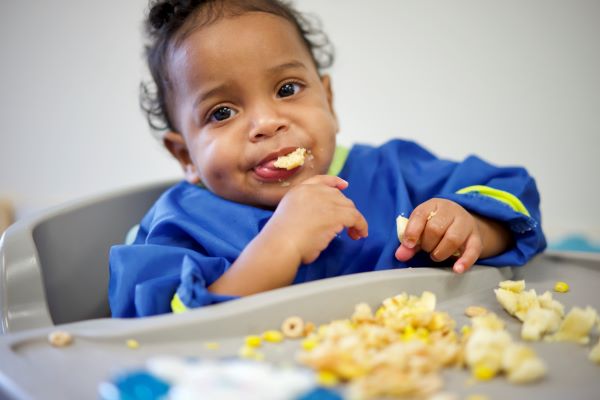 Children under 4 are at a high risk of choking while eating. Young children are still learning how to chew food properly, and they often swallow the food whole. Food can easily block their small airways. To help prevent choking, do not serve small (i.e., the size of marbles), sticky, or hard foods that are difficult to chew and easy to swallow whole.
Children under 4 are at a high risk of choking while eating. Young children are still learning how to chew food properly, and they often swallow the food whole. Food can easily block their small airways. To help prevent choking, do not serve small (i.e., the size of marbles), sticky, or hard foods that are difficult to chew and easy to swallow whole.
Staff can help reduce a child’s risk of choking by preparing food in certain ways. Cut large or round food into smaller pieces, and cook hard food, like carrots, until soft enough to pierce with a fork. Avoid spoons of peanut butter or other nut butters. Spread nut butters thinly on other foods (e.g., toast, crackers). Serve only creamy, not chunky, nut butters.
Children always need to be supervised during meals and snacks. Staff are best seated within arm’s reach during mealtimes.
Tips and Strategies for Preventing Choking
- Cut round or tubular foods (e.g., hot dogs, grapes, cherries, cherry tomatoes, melon balls, etc.) into smaller pieces. Slice these items in half the long way. Then slice into smaller pieces (no larger than ½ inch).
- Remove seeds, pits, and tough skins and peels from fruits and vegetables.
- Cut foods into thin slices, strips, or small pieces (no larger than ½ inch), or grate, mash, or purée foods. This is especially important when serving raw fruits and vegetables, as those items may be harder to chew.
- Remove all bones from fish, chicken, and meat before cooking or serving.
- Grind up tough meats and poultry.
Avoid foods that are choking hazards:
- Cheese cubes
- Popcorn
- Dried fruit or gummy fruit snacks
- Hard candy, including caramels, cough drops, jellybeans, lollipops, etc.
- Hard pretzels and pretzel chips
- Marshmallows
- Nuts and seeds, including breads, crackers, and cereals that have nuts and seeds
Learn More
Read more:
Resource Type: Article
National Centers: Health, Behavioral Health, and Safety
Audience: Directors and Managers
Last Updated: October 31, 2023